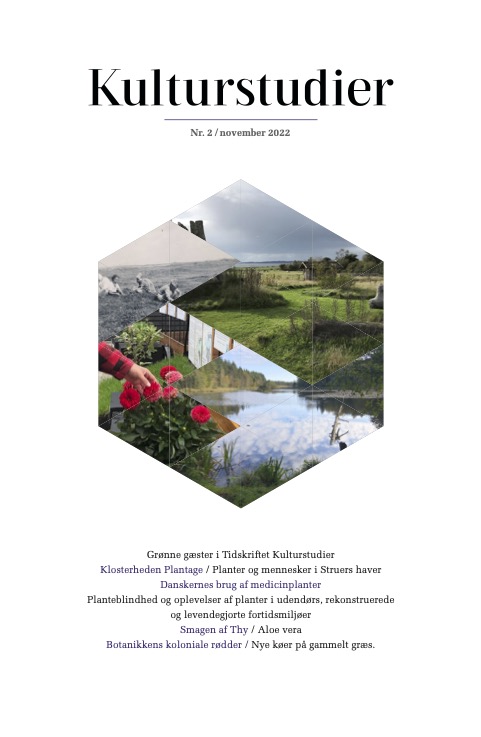Planter og mennesker i Struers haver
Formidling af planter på et kulturhistorisk museum
DOI:
https://doi.org/10.7146/ks.v13i2.134659Nøgleord:
plante-menneske relationer, Museumsudstilling, publikumsundersøgelseResumé
Hvordan skaber vi plads i det kulturhistoriske museum til at undersøge, forundres over, sanse, reflektere og øge bevidstheden om planternes rolle i menneskelivet? I artiklen beskrives og analyseres et forsknings- og formidlingsprojekt på Struer Museum med særligt fokus på haveejeres relationer til planter, og altså de bio-sociale møder, der finder sted i private haver. Artiklen beskriver et udstillingsarbejde, hvor levende planter blev gjort til centrale genstande, og hvor der blev lagt særligt vægt på at katalysere refleksion hos publikum over egne og andres relationer til haven og dens planter. Gennem en publikumsundersøgelse identificeres og diskuteres, hvordan udstillingen, dens budskab og formål, omsattes til oplevelse og refleksion hos publikum.
Referencer
Bencard, Adam 2014. „Presence in the museum. On metonymies, discontinuity and history without stories”. Museum and Society, 2014: 12(1), s. 29-43. Bencard, Adam 2018: „Why Looking at Objects Matters: An Argument from
the Aesthetic Philosophy of Alexander Gottlieb Baumgarten.” Museum
Worlds, 6(1), s. 48-59.
Bhatti, Mark; Church, Andrew; Claremont, Amanda & Stenner, Paul 2009: „‘I love being in the garden’: enchanting encounters in everyday life.” Social & Cultural Geography, 10:1, s. 61-76.
Brichet, Nathalie S. & Hastrup, Frida 2019. „Curating a Mild Apocalypse: Researching Anthropocene Ecologies through Analytical Figures”, Hansen, Malene Vest, Henningsen, Anne Folke & Gregersen, Anne (red.) Curatorial Challenges: Interdisciplinary Perspectives on Contemporary Curating, s. 120- 32, London: Routledge.
Davis, Dona Lee & Maurstad, Anita 2016: „Horse Things: Objects, Practices and Meanings on Display”. Davis, Dona Lee Davis & Maurstad, Anita (red.): The meaning of horses: biosocial encounters. Routledge, 2016
Dudley, Sandra H. 2012: „Encountering a Chinese horse”. Museum objects: Experiencing the properties of things, 2012, s. 1-14.
Fenske, Michaela Katharina; Elpers, Sophie & Fenske, Michaela 2020: „Multispecies Worlds in the Museum”. Ethnologia Europaea 2020: 49/2.
Frandsen, Thomas Østergaard 2021: „Mennesker og planter i Struers haver“. I: Det lokalhistoriske magasin – Struer 2022, Struer Museum, s. 26-36.
Harrison, Rodney 2015: „Beyond “natural” and “cultural” heritage: Toward an ontological politics of heritage in the age of Anthropocene”. Heritage & society, 2015: 8(1), s. 24-42.
Hitchings, Russell 2003: „People, plants and performance: On actor network theory and the material pleasures of the private garden”. Social & Cultural Geography, 2003: 4/1, s. 99-114.
Ingold, Tim & Palsson, Gisli (red.). 2013: Biosocial becomings: integrating social and biological anthropology. Cambridge University Press.
Law, John 1994. Organising modernity: Social ordering and social theory. John Wiley & Sons.
Lindauer, Margaret 2005: „What to Ask and How to Answer: A Comparative Analysis of Methodologies and Philosophies of Summative Exhibit Evaluation”. Museum and Society, 2005: 3, s. 137–152.
Macdonald, Sharon 2002. The Active Audience and the Politics of Appropriation. Sharon Macdonald: Behind the scenes at the science museum. Berg Publishers, s. 217-243.
Maurstad, Anita 2010: „Cultural performances of cod-at Tromsø University Museum”. Tidsskrift for kulturforskning. 2010: 9(1).
Mol, Annemarie 1999: „Ontological politics. A word and some questions“. The Sociological Review. 1999: 47, s. 74-89.
Meyer, Kathrin & Judith Elisabeth Weiss 2019: „Von Pflanzen und Menschen: Über ein ungleiches Verhältnis”. Kathrin Meyer & Judith Elisabeth Weiss (red.). Von Pflanzen und Menschen: Leben auf dem grünen Planeten. Göttingen: Wallstein Verlag, s. 10–13.
Olsen, Bjørnar 2010. In defense of things: archaeology and the ontology of objects. Rowman Altamira.
Rehwagen, Ulrike 2017: „Bio – Biotop – Biotopia: Ein Museum des Lebens”. Aviso, 2017: 4. s. 42–45.
Reinert, Wiebke 2020: „Enlivening Exhibitions: Zoos, Open-air Museums, and the History of Living Animals in Human Sceneries of Display”. Ethnologia Europaea, 2020: 49(2).
Schimek, Michael 2020: „Between Reconstruction of the Past, Visitor Expectations and Animal Well-being: Told and Untold Stories about Human– Animal Relationships at Open-air Museums”. Ethnologia Europaea, 2020: 49(2).
Thorsen, Liv Emma (2018). Animal matter in museums: Exemplifying materiality. Kean, Hilda & Howell, Philip (red.). The Routledge Companion to Animal-Human History. Routledge. s. 171-193.
Uchida, Maholo & Peng, Jingyu 2018: Feeling the exhibition: Design for an immersive and sensory exhibition experience. Drotner, Kirsten; Dziekan, Vincent; Parry, Ross & Schrøder, Kim C. (red.). The Routledge handbook of museums, media and communication. Routledge. s. 306-214.
Downloads
Publiceret
Citation/Eksport
Nummer
Sektion
Licens
Tidsskriftet forbeholder sig ret til førsteudgivelsen, mens ophavsretten til artiklen tilfalder forfatteren.
Artikler udgivet af Kulturstudier licenseret under en Creative Commons Navngivelse-IkkeKommerciel-IngenBearbejdelse 4.0 International Licens





